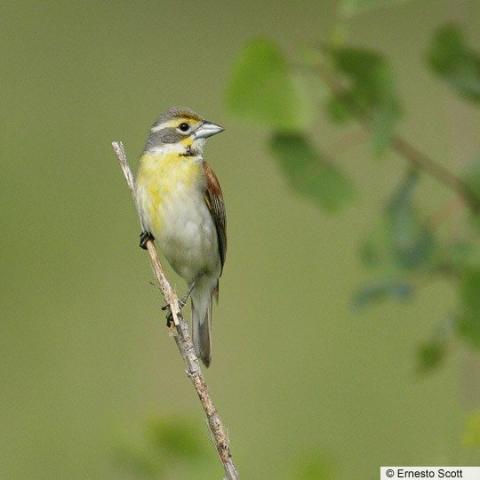Posted 01/15/14
Brooke Bateman has discovered that migratory songbirds in the Midwestern United States, such as Dickcissels, reliably respond to short-term changes in weather. By looking at weather and bird observation data from 1950-2011, Brooke has discovered that these highly mobile grassland birds flee extreme drought events by dispersing to the northern limits of their range, where they become more common. Brooke hopes that by using computer models to combine weather and bird data with satellite images, she can build explanatory computer models that inform conservation efforts and help mitigate the effects of weather extremes on migratory songbirds.

Researchers around the world continue to compile evidence linking changes in the ranges of plants and animals to shifting climate patterns and discussing the consequences these changes will bring to the biosphere. Climate change is measured over years and decades, however, and researchers have recently started to question how plants, animals and ecosystems respond to fluctuations in weather at smaller time scales, like short term heat waves or cold snaps. Brooke Bateman is at the vanguard of this research and has built her career on studying the impacts of both climate patterns and weather events on the distribution of animal species. While her work here at SILVIS is just beginning, Bateman has already found that certain species, such as Dickcissels, do a remarkable job of responding quickly to weather events here in the Midwest. This connection between weather and birds is a new wrinkle into the complicated impacts of changing climate and weather patterns, and Brooke is just starting to untangle what it means for birds and conservation.Weather and climate are closely related and they are both important with regards to the distribution of plants and wildlife. There are important differences, however. Climate is the longer-term average of lots of individual weather events. Anybody who has compared the average temperature for a city at a given calendar date needs only to look at the record high or low temperatures for that date and location to appreciate how much weather variability can exist within long-term climate trends. This variability, in the form of heat waves or cold snaps over time for a place is critically important in shaping the distribution of plant and animal species. For example, studying changes in climate patterns may give you an indication of how a species’ range may shift over time, such as the northern expansion of fire ants as winters become less severe. The impacts of weather, however, mean that while on average a plant or animal species may find suitable conditions in a certain place, extremes of cold, heat or drought may not be suitable and may force the plants or animals to move or succumb to these weather events.Brooke has found that between the two options of moving and perishing, Dickcissels are pretty good at moving in response to weather and extreme events such as drought. The Dickcissel is a smallish songbird that is a common breeder in the plains and fields of the Midwestern United States whose range has not changed all that much over the last forty years. The distribution of Dickcissels within their range, however, has changed a great deal. Bateman knows this because she has combined large datasets that contain weather information for the continental United States and data from the Breeding Bird Survey, a 46-year old monitoring effort that documents every bird encountered along 24.5 mile transects that are spread across the country. From these data Brooke can show how the areas that reported the most Dickcissels matched areas of suitable weather from 1950-2011. These results show that during extreme drought in their core breeding areas, Dickcissels are more prevalent on the northern edge of their range.

Brooke has just started to uncover the patterns of how weather affects the distribution of birds in the Midwest, but already these results have begun to raise questions she is exploring. Questions like, ‘What mechanisms underlie birds fleeing extreme weather events and what are the longer-term impacts on a population that is forced to move longer distances? Also, ‘What do these patterns mean for managers and conservationists attempting to buffer the impacts of weather events and longer-term climate patterns on highly mobile species, such as birds? To answer these questions, Brooke is linking patterns of weather records and bird abundance data to satellite imagery that accurately tracks the short-term weather events. She’s using these different data sets to build computer models to help explain these patterns. Brooke hopes that by providing a more detailed understanding of songbird response to short-term weather fluctuations, land managers and conservationists can accurately prepare and plan them. While we may not be able to reduce future temperatures or the severity of droughts across the entire Midwest, it is possible to create and manage small parcels of land to act as a refuge against these events and hopefully ensure that species sensitive to weather and climate, such as Dickcissels, continue to have a place to go as the climate changes.”
Story by James Burnham
